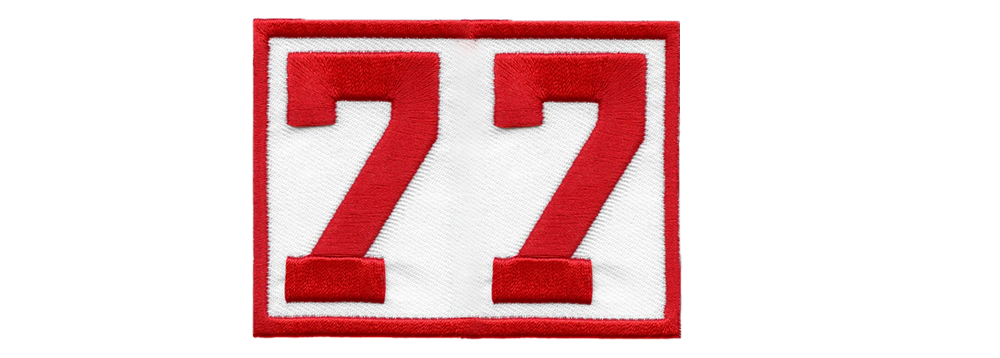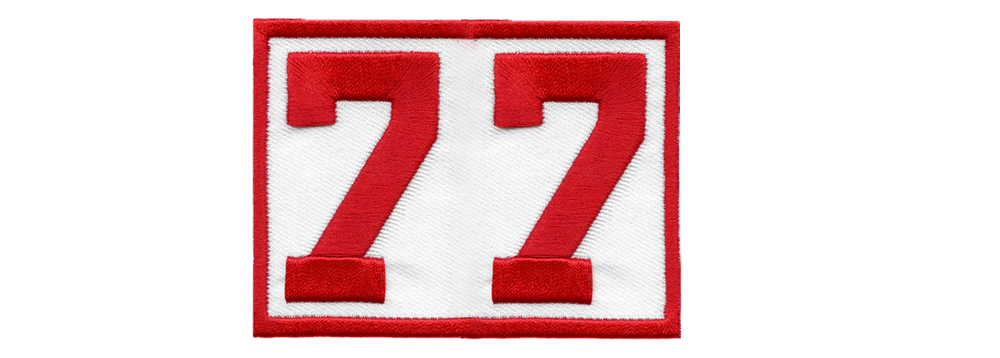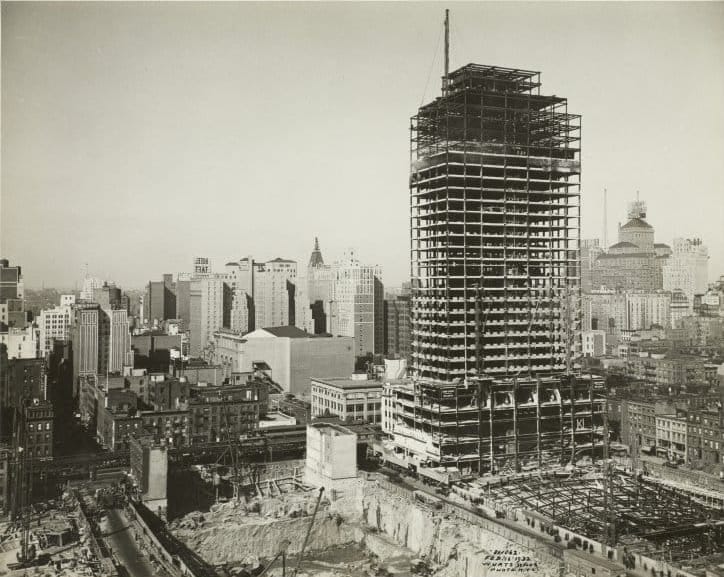New York is a city not just filled with iconic things but an icon itself. Central Park, The Empire State Building, The Museum of Natural History, Broadway, Wall Street, The Guggenheim, do I need to go on? Yes. Thanksgiving Day Parade, The Chrysler Building, Yankee Stadium, Madison Square Garden, Lincoln Center, The Brooklyn Bridge, The Flatiron, Greenwich Village. All of these make the city more than just a location on a map. One place that plays a big part in New York being New York is Rockefeller Center. Many know the area that sits between 48th Street and 51st Street and Fifth and Sixth Avenue for its Christmas tree seasonal tradition that goes back to 1931 when "[construction] workers at Rockefeller Center pooled their money together to buy a Christmas tree." They also might have seen the legendary tree in movies like Home Alone 2: Lost in New York, or Elf.
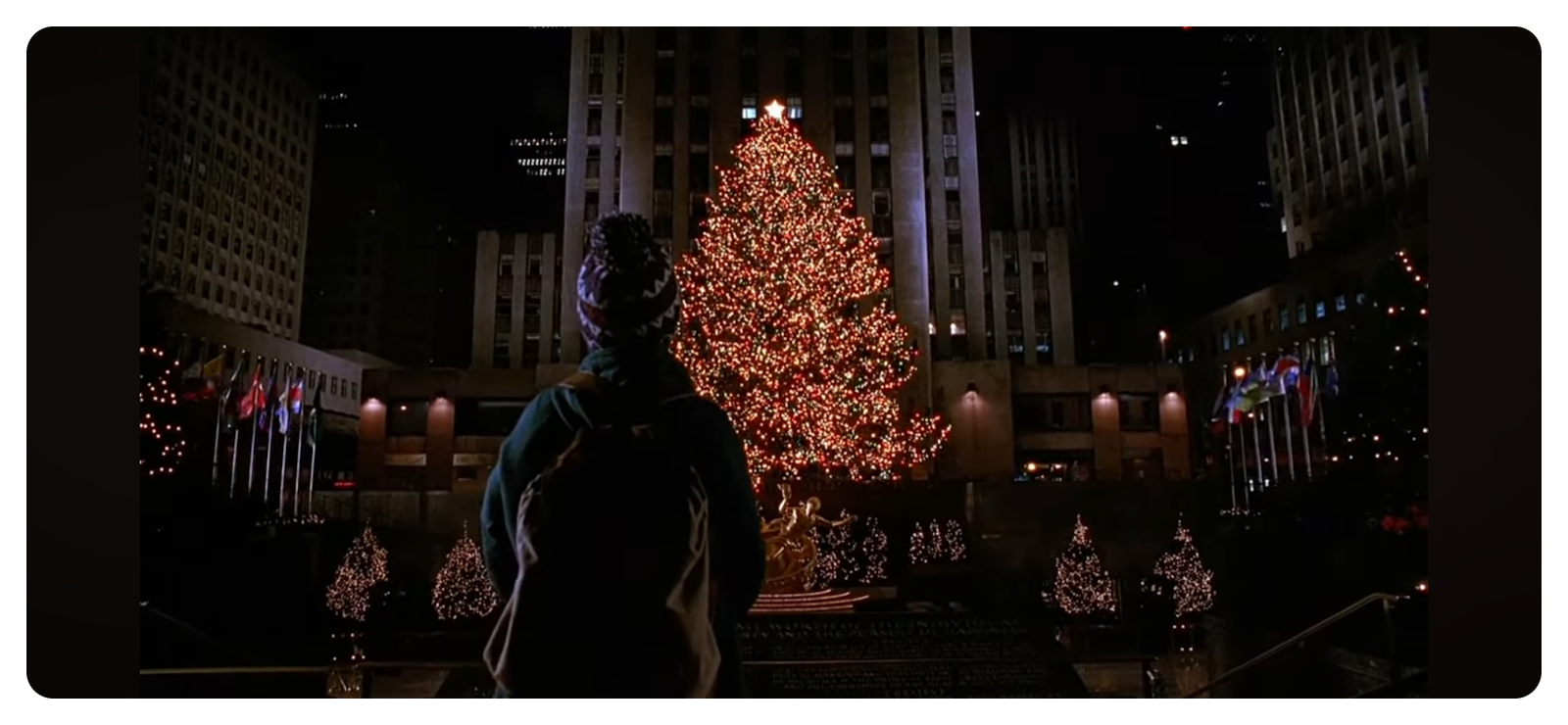
The massive tree is a significant reason so many flock to the bustling streets of Midtown in the winter, but there is so much more to Rockefeller Center. Let's take a look back at its beginning.
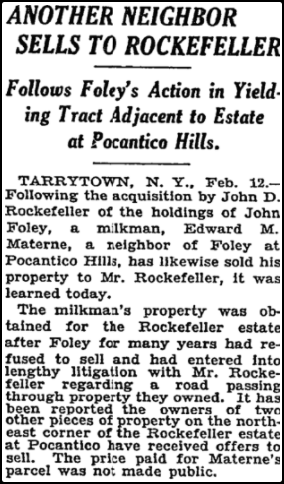
February 13, 1928: There was some news about John D. Rockefeller having a back and forth with a land owner but eventually settling negotiations and buying his and another neighbor's New York land. Even though the deal to lease Rockefeller Center would happen this year, this particular deal was for his estate in Pocantico Hills, around 30 miles north of where Rock Center is now. He would go on this year (like many years before and after) to buy a significant amount of land in and around New York City.

May 11, 1928: Early rumblings of what would be, as the Rockefellers win a legal zoning battle and can move on with the area at West 53rd Street between 5th and 6th Avenue being changed from a residential to a business district.
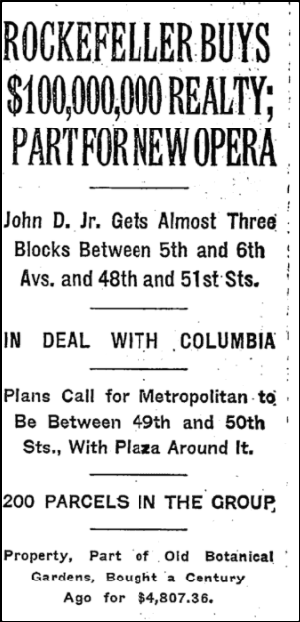
December 28, 1928: It is reported that John D. Rockefeller buys the blocks between 5th and 6th Avenues and 48th and 51st Streets from Columbia University for a "record breaking" amount. It was said in the initial article that the area was not for Rockefeller Center, but the new Metropolitan Opera Building, as one of the original plans was that the Opera House fit into the large commercial area. This plan was a fatality of the newly horrific economy, and the deal would ultimately be a lease for the property.
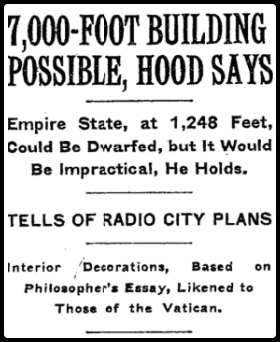
January 17, 1932: Raymond Hood, who would lead the design of Rockefeller Centre, said during a lecture at the Brooklyn Institute of Arts and Sciences that the "theoretical" building limit for skyscrapers was 7,000 feet (the tallest building in the world today, 92 years later, is 2,716.5 feet). He would say it was somewhat impractical but possible due to his studies.

February 24, 1932: The project receives its first public and official designation, "Rockefeller Centre," and the "digging on 5th Ave" has begun.
March 19, 1932: Plans for the buildings emerge as there will be supposed "roof bridges" connecting three buildings. They will be done in a "decorative" and "ornamental" way.
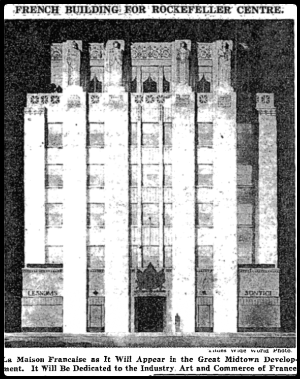

March 31, 1932: Rockefeller "City" makes an addition to its collection by planning to erect a building at 610 Fifth Avenue to be named "La Maison Francaise" which directly translates to "The French House." This will be the twin building to the British Empire Building at 620 Fifth Avenue. It is noted that the street level floor of this building will be devoted to shops and the total height of the building will be 85 feet (it is 90 today).
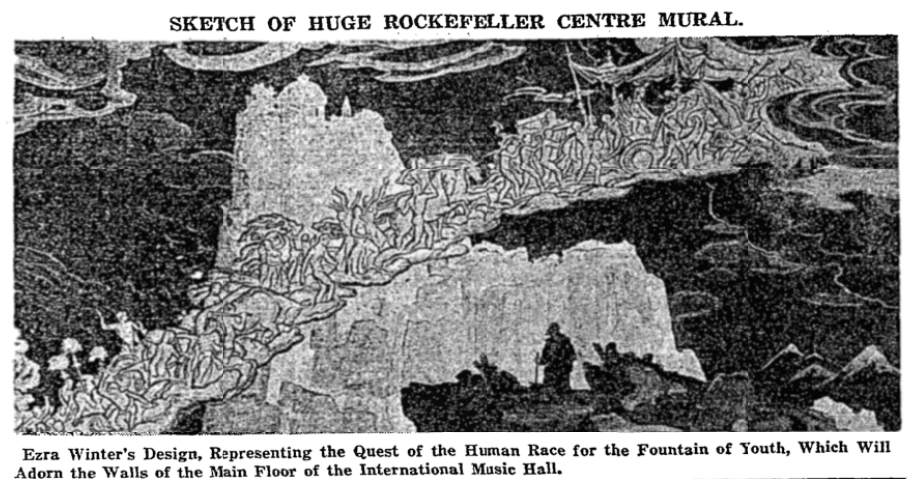
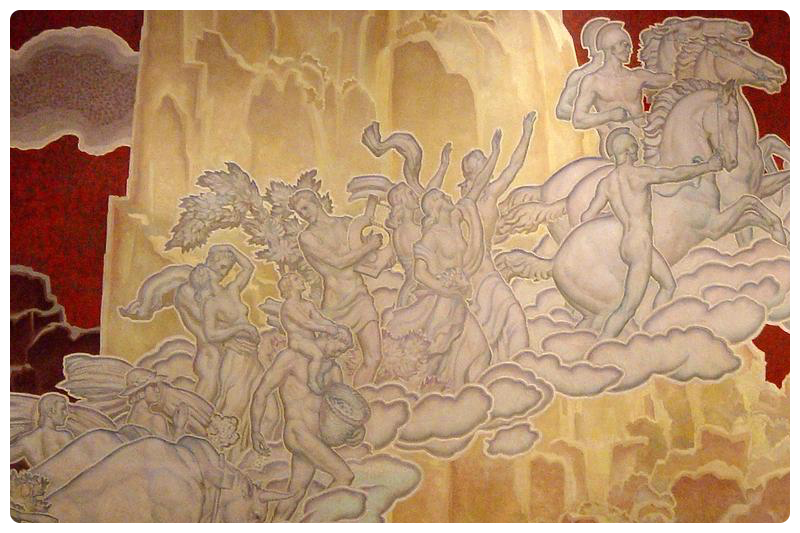
April 20, 1932: After being awarded the job on March 5 earlier that year, Ezra Winter, a Michigan born muralist, completes his first sketch of the Fountain of Youth, which now is in the "Main staircase from grand foyer to first mezzanine [at] Radio City Music Hall."
September 27, 1932: The steel frame of the RCA building in Rockefeller Center is completed as the limestone and plastering are being applied.
November 20, 1932: The Radio City "Towers" project gets an entire page in the Times lauding its impressive mass and act of construction. The article starts, "Travelers along Fifth Avenue in the November sunshine cannot help having their eyes caught up to the sky by the towering mass of great unfinished building which is set back in an open space so big that looking up at it is sensibly less a neck breaking operation than looking up at most of our skyscrapers rising steeply from the sidewalk." (Wendell McRae, New York Times 1932)
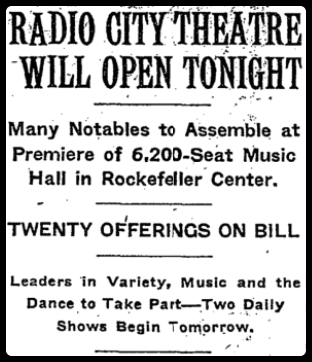
December 27, 1932: Radio City has its first broadcast the day after Christmas, and then the next day, on the 27th, Radio City opens its doors, and it is said that "every seat in the 6,200-seat theater is expected to be filled." The "opening bill" involved Titta Ruffo, the Italian opera singer, and Harald Kreutzberg, the German dancer, among others. It was later announced that this newly minted building would host stage productions.
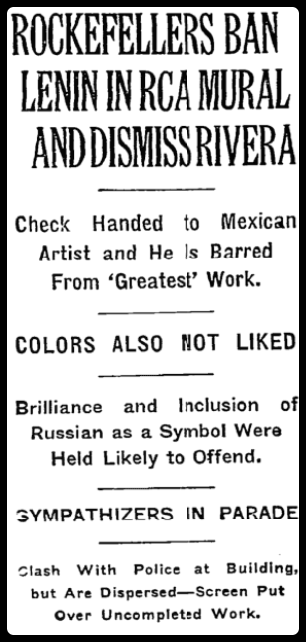
May 10, 1933: It is announced that the artist who was previously given the job of making a mural for the Rockefellers, Diego Rivera, is fired or "dismissed" for including Vladimir Lenin in his mural. He was paid in full by the Rockefellers, but his work would not be shown in the lobby of the RCA building, where it was originally meant to be seen. Later in the following days, weeks, and months, many artists would send pleas to the Rockefellers to include the painting done by Rivera. It would later be cut from the wall in February of 1934, but he would reproduce the art a year later for Mexico's Palace of Fine Arts.
July 1, 1933: Rockefeller City will add two more future buildings, A German building and an Italian nine story counterpart. Oddly enough, the Italian building that was to be named Palazzo d'Italia was approved by Benito Mussolini two years before Italy invaded Ethiopia and four years before Italy left the League of Nations with Germany.
October 7, 1933: The plan is heard by the public for the first time that tunnels will connect the Rockefeller City building. There would be a lower level for vehicular transport and an upper level for shops called "the concourse" we still know today. The tunnel system would get "tentative" approval on December 13, later that year. It was later announced on May 22, 1934, that there would be a "huge" underground ramp for trucks to aid the traffic.
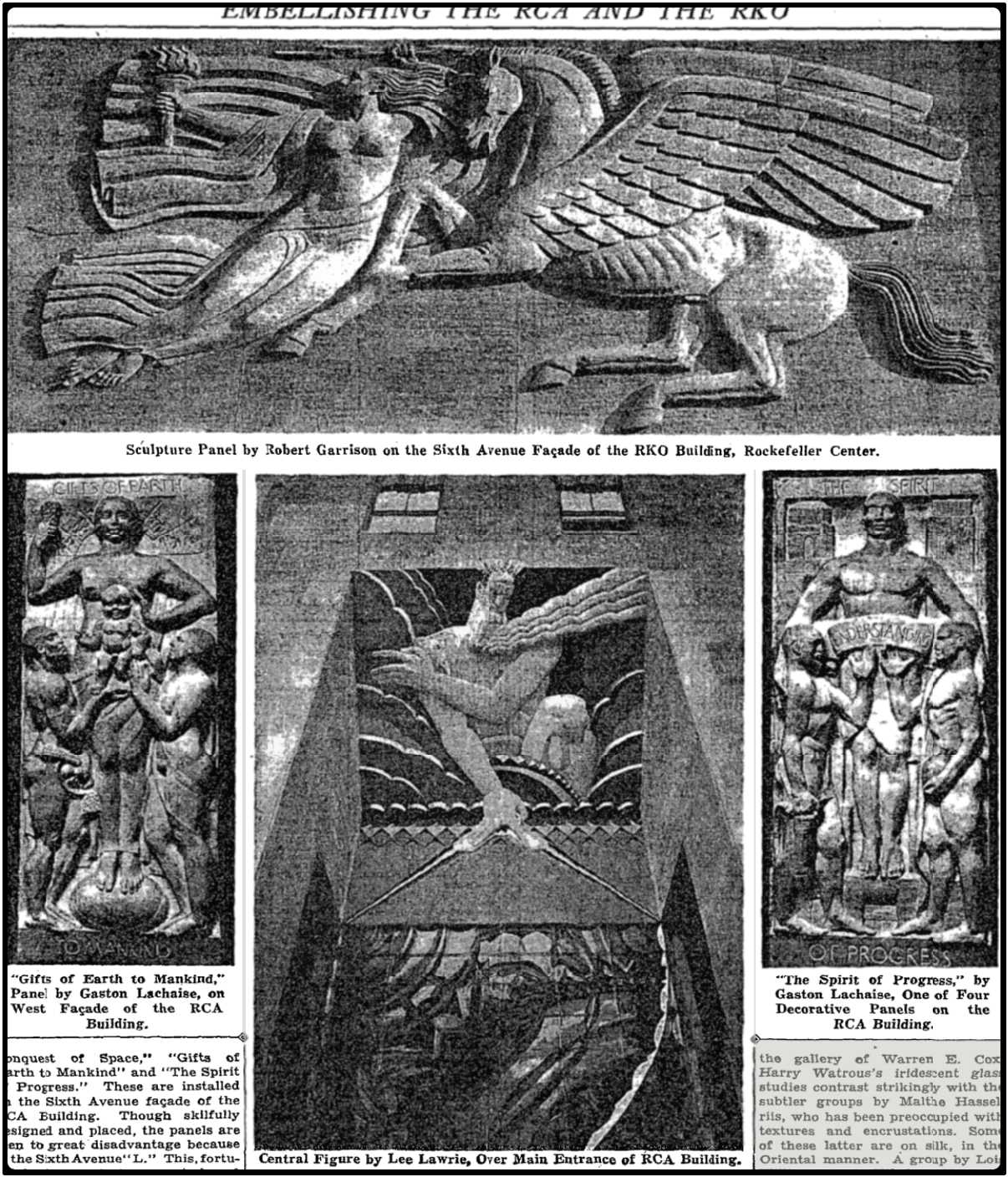
December 24, 1933: The sculpture and murals that were recently installed at the RCO and RKO building are shown and surveyed.
January 11, 1934: The Rockefeller group is sued for "unfair competition and coercion in obtaining tenants" for their new up and coming Rockefeller Center. It was alleged that the Rockefeller Group encouraged some to "ignore" their current leases and were given sizable amounts of money to have their offices at the new Rockefeller buildings.

June 8, 1934: The limestone sculpture by the French Artist Alfred Janniot is shown to the public for the first time at the La Maison Française 5th Avenue entrance, where it still is today; it was showcased to show the French Republic.

August 14, 1934: Raymond Hood, the architect who created the Radiator Building on West 40th, the Chicago Tribune Tower, and Rockefeller Center, dies at his house in Stanford, Connecticut. Hood would not see his finished work.
September 2, 1934: An entire page in the New York Times is dedicated to "real gardens to grow on the roofs of Radio City," praising the future of horticulture. Earlier on August 22, it was announced that a "nightclub" is said to be on top of the central tower of Rockefeller City, the RCA building. The nightclub would change form later on to be the well known Rainbow Room.
September 30, 1934: A Column by Brooks Atkinson makes the stand that the two newly opened Rockefeller Center theaters are too much; "nothing of much constructive value is accomplished by observing that they are too large for dramatic enjoyment." And there is some caution about the sustained success of "motion pictures."
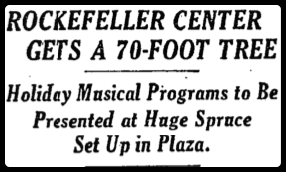
December 19, 1934: A year after the first lighting, it was made an annual tradition, a 70 foot tree from Babylon, Long Island, is put up in the plaza of Rockefeller Center and lit. The tree erected the following year in 1935, would be 80 feet.
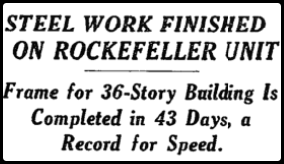
November 28, 1936: 9,000 pounds of steel were constructed in a record 43.2 working days. This building would end up being Nine Rockefeller Plaza. It is mentioned in the announcement article that the original excavation for this specific building involved 46,600 tons of earth and rock before laying any structure.
Skating on the rink the following year in 1937, from MCA/Universal Pictures Collection, 1929 - 1967
December 25, 1936: For the first time, the rink would be open for the public to skate on starting at 10 a.m. on Christmas day. It is said in the New York Times article that Rockefeller Management say the rink will be the the first of its kind. The following year, in 1937, the rink would open in November, and there would be four available skating sessions a day.

December 28, 1936: A new piece of work will join the many at Rockefeller Center. A statute of Atlas, which, along with Prometheus, has become the iconic symbol of Rockefeller Center today. The German born Lee Lawrie will make the 15 foot high sculpture. At the time of the announcement, the statute was being "cast into bronze" but not erected yet. The 14,000 pound work was also done in collaboration with Rene Chambellan, who modeled it in a sketch.

April 1, 1937: The first tenants move into the newly built 9 Rockefeller Plaza after the highly anticipated building was constructed an entire month ahead of schedule. "9 Rock" would later fill up and get ten new tenants in the following weeks.

May 23, 1937: John D. Rockefeller, oil magnate and philanthropist, dies at age 97. He would die at his Florida home in the previous months, there are many articles about his family members and friends visiting him and updating him on "his" midtown project.
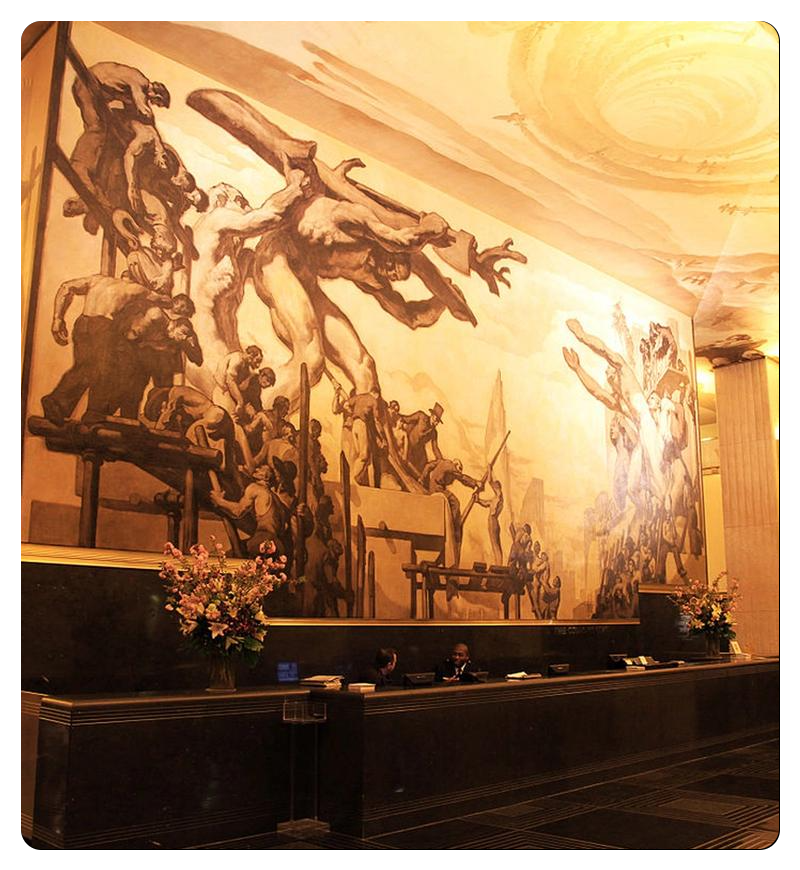
December 21, 1937: Jose Maria Sert's mural, American Progress, fills in the empty spot that Diego Rivera's controversial mural was going to be. Sert's murals is of "a vast allegorical scene depicting the development of America over three centuries."

January 25, 1938: Rockefeller Center leases to the Associated Press, a lease that would last 66 years, ending in 2004. It was announced that the building that AP would inhabit would be ready by the fall of 1938 and that they would have four floors. Today, there are many infamous Rockefeller Center tenants like Saturday Night Live and The Today Show; in the past, the most well known tenant was the Associated Press, where they had their headquarters. The sculpture done by Los Angeles born Isamu Noguchi that is shown above the primary entrance for 50 Rockefeller Plaza shows multiple journalists wielding a typewriter, notepad/pen and paper, and camera showcasing the "News" and Associated Press.
May 7, 1939: In multiple Rockefeller City buildings, there is a continuous rise in tenants that bring in revenue for the Rockefeller Group. At a time when many companies and groups start switching headquarters and office spaces, many move to the "city within a city". Almost every week a couple of new leases are announced for the soon to be completed project.
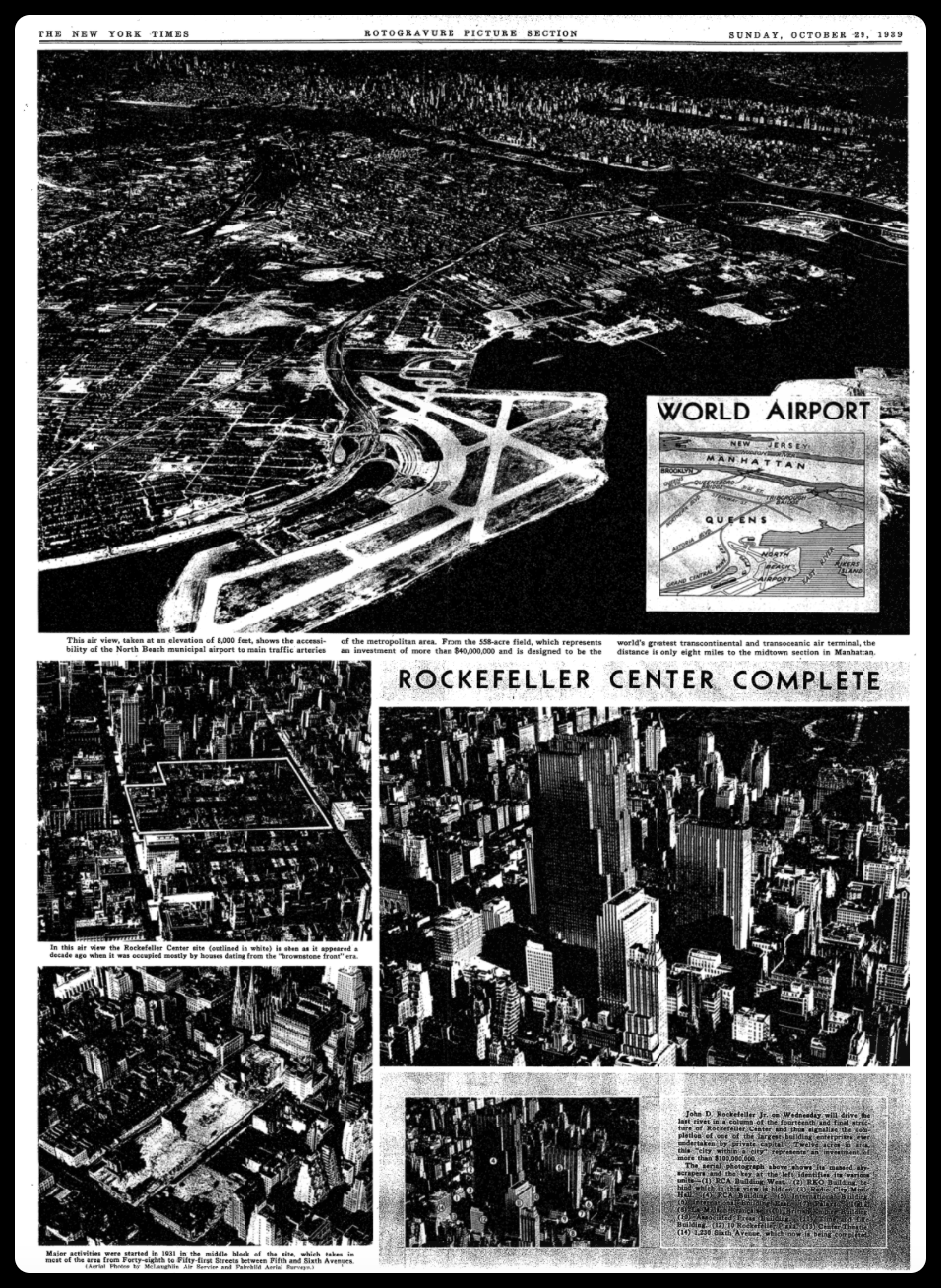
October 29, 1939: A full page of the New York Times is dedicated to the Rockefeller project, announcing that it is no longer "in progress." Rockefeller Center is completed and a couple days later on November 1, John D. Rockefeller Jr. would infamously lay the last rivet, which you can still see today. After doing it, Rockefeller Jr. said, "devote ourselves tirelessly and persistently to the maintaining of peace and the preservation of our priceless heritage-the freedom of the individual." Rockefeller was and still would go on to be an incredibly outspoken figure for workers' welfare.
March 8, 1940: 87% of Rockefeller Center is leased. By this point in 1940, around 2,200 people worked in Rockefeller Center, including Radio City, according to the New York Times.
December 14, 1940: Subway on 6th Avenue opens, and many use their nickel (yes, that was the fare) to try it. It is reported in the Times article that the subway project cost around $59,500,00.
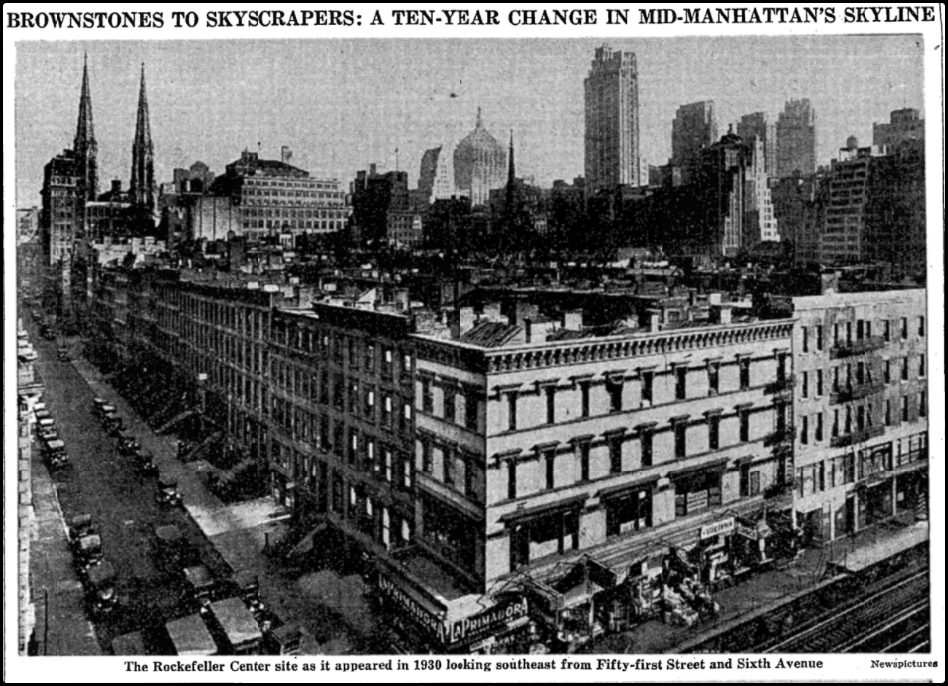
Photo credit to: New York Times, New York Daily News, New York Public Library, Clémentine Delplancq, 20th Century FOX/Disney, MCA/Universal Pictures Collection, and Rockefeller Center.
